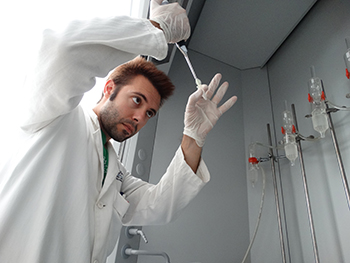
Most beekeepers probably think they know where their honey comes from. For example, when goldenrod blooms around the Dyce Lab in upstate New York in September, I’m pretty sure that’s what my bees are visiting and turning into “goldenrod honey.” During apple bloom in May, it’s “apple blossom honey.” In November and December in New Zealand, it’s “manuka honey.”
But what do we really know? How much goldenrod nectar is actually in “goldenrod honey?” How much manuka nectar is in “manuka honey?” And are we naïve to think that bees are only collecting plant nectar to make honey? What about other sources of sugar, such as honeydew from insects? These are the topics for our tenth “Notes from the Lab,” where we highlight “Entomological signatures in honey: an environmental DNA metabarcoding approach can disclose information on plant-sucking insects in agricultural and forest landscapes,” written by Valerio Utzeri and colleagues and published in the journal Scientific Reports [8:9996 (2018)].
The question of where honey comes from is not new. In fact, there’s a longstanding field of study on the topic called melissopalynology (from the Greek words meli and mellisa, meaning “honey” and “bee,” and palynology, the “study of pollen”). Melissopalynologists spend lots of time at the microscope looking for pollen grains in honey. Those pollen grains, which are picked up by accident as the bee forages for nectar, provide clues to the honey’s origin, since pollens from different plants can look very different.
But mellisopalynology is not an exact science. Sometimes pollens from different plant species look similar under the microscope. Also, because bees accidentally pick up different amounts of pollen at different plant species, it’s difficult to estimate exactly how much nectar a particular plant species contributes to the honey. And to be honest, it is a little odd to focus on pollen while trying to figure out where the nectar comes from. Why not just look at the honey directly?
Recently, major improvements in DNA sequencing allow us to look directly at honey to infer its origins. In fact, the whole field of palynology is going through a bit of an upheaval as DNA metabarcoding stands to replace traditional palynology approaches. But what new insights can these metabarcoding methods provide? This is the question Utzeri and colleagues were interested in pursuing.
For their study, Utzeri and colleagues purchased 13 different honeys from Italy, France and Eastern Europe. They extracted DNA from the honeys, amplified the DNA by a process called PCR, then sequenced the PCR products (essentially lots of copies of the original DNA) with a new DNA sequencing technology. Then the real work began. Because the new sequencing technology yields lots and lots of data, the authors spent lots and lots of time putting the DNA puzzle together. They assembled the DNA sequences from the honey and checked them against known DNA sequences from plants and animals.
So what did they find? Is honey coming from where beekeepers think it’s coming from? To a large degree, ….


